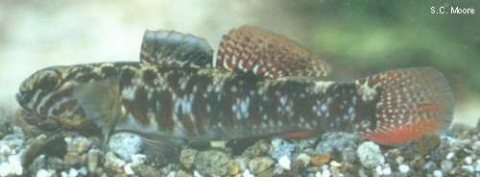Bullies (Eleotridae)

Members of the bully family occupy marine and fresh waters in the tropical Pacific and southeast Asia. There is just one freshwater genera in New Zealand, Gobiomorphus, with seven species:
Gobiomorphus alpinus (Tarndale bully) Gobiomorphus basalis (Crans bully) Gobiomorphus breviceps (upland bully) Gobiomorphus cotidianus (common bully) Gobiomorphus gobioides (giant bully) Gobiomorphus hubbsi (bluegill bully) Gobiomorphus huttoni (redfin bully)
Bullies have rounded tails, two dorsal fins, a blunt head, and are quite stocky. They can sometimes be recognized by their habit of sitting on the substrate looking almost as if they were standing up on their forward fins. They have a darting method of swimming and usually remain on or close to the substrate.
Amateurs will have difficulty distinguishing the bully species except for the bluegill and redfin bully, which have some obvious unique characteristics. Fish biologists have to rely on fin ray counts and scale patterns to correctly identify the species, and this usually requires examination of specimens under a microscope. Identification is complicated by the overlapping distribution of many of the species.
Of the seven species of Gobiomorphus found in New Zealand, three are strictly diadromous (bluegill, redfin, and giant bullies), while three are non-diadromous (Crans, upland, and Tarndale bullies). The common bully can be either.
